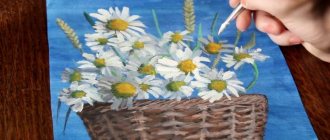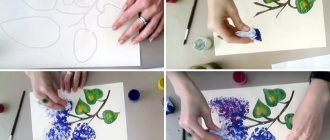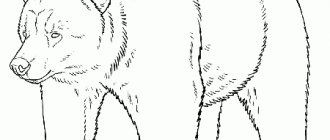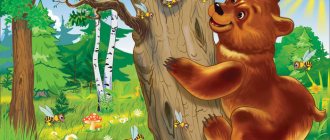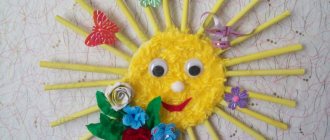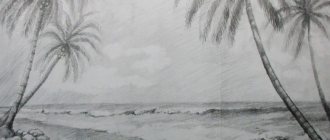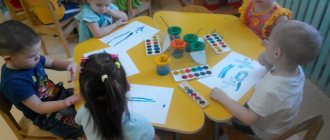Preparation for a drawing lesson on the topic “Mushrooms and Berries” in the preparatory group of a kindergarten
Drawing is one of the main forms of creative activity of a child. Classes held in kindergarten serve the harmonious and emotionally positive development of the preschooler, prepare for primary school and develop personal qualities. Working with a brush, pencils and felt-tip pens develops fine motor skills and prepares the hand for mastering an important skill for future life - writing. In drawing classes, a child gains knowledge about colors and shades, learns to see beauty in various color combinations. Spatial thinking develops, the concepts of composition and perspective are reinforced. Figurative memory and thought processes are activated.
Drawing lesson in the preparatory group
Objectives of teaching drawing in the preparatory group
- Development of aesthetic feelings: color and compositional perception of objects, sense of form, rhythm, proportion. By directing children to a specific visual perception of objects, the teacher must teach them to see the beauty of objects and the unique properties of objects.
- Development of spatial thinking, consolidation of compositional abilities. Older preschoolers should be able to create a three-plane composition.
- Learning to highlight the main or most significant properties of an object using color, image size, and location in the foreground of the picture.
- Development of drawing skills based on ideas (on themes of the surrounding reality, based on fairy tales).
- Encouragement for independent creative activity, activation of the child’s imagination.
Pupils of the preparatory group are familiar with the main types of drawing and use various techniques and techniques to realize a creative idea:
- Subject drawing.
Subject drawing from life in the preparatory groupChildren learn to realistically convey in a drawing the characteristic shape of an object or its parts, respecting proportions, color, volume, and movement. Children aged 6–7 years are actively developing analytical thinking, they learn to identify common features of objects and the features by which they differ from one another. Drawing is not carried out in classes in the senior and preparatory groups. It is possible to examine samples of finished works on a given topic, discuss execution techniques, and drawing techniques. There is no direct demonstration of actions. It is recommended that, while studying technology maps and visual instructions, together with students, build an oral plan for performing actions. Great importance is given to drawing objects from life: children learn to convey the characteristic features of structure and form using specific examples. In the preparatory group, children draw objects based on their imagination, using images from their visual memory and following their imagination.
- Subject drawing.
An example of plot drawing based on presentation in the preparatory group
Preschoolers learn to convey their impressions and sensations by drawing objects and displaying their understanding of the connection between them and interaction. In the preparatory group, children are given the opportunity to independently come up with a plot (small scene) on the topic of the lesson. The compositional abilities of young artists develop: they arrange the drawing over the entire area of the sheet, learn to determine the position of objects - foreground and background. In the graduating group of kindergarten, children master the ability to convey the characteristic movements of objects, overcome the conventionality and static nature of the image.
- Decorative drawing.
Painting with a pattern of berries and leaves in the preparatory groupLearning to decorate a paper blank or papier-mâché figurine fulfills the requirement of developing aesthetic taste in art classes. Preschoolers get acquainted with the folk crafts of our country, learn to see beauty in the products of craftsmen from the people. The children use the acquired knowledge about the features of Gzhel, Khokhloma, and Gorodets paintings in creating their own patterns based on folk painting.
For the topic “Mushrooms and Berries” in the preparatory group, the most relevant is subject drawing from life or from an idea: “Spruce branches”, “Bunch of rowan berries”, “Fly agaric”, “Mushrooms in the forest”, “Family of honey mushrooms”, etc. Guys They practice the skills of creating a composition, arranging objects on a sheet of paper, learning to fill the entire sheet with a drawing, and creating an unusual background. Drawing from life will be the main method in school. In the preparatory group, students are not tasked with depicting the volume of an object or creating light and shade. The goal in teaching children 6–7 years old is to learn to identify the features of an object in front of them and display them in a drawing: the shape of the object, its parts, the relationship of parts with the main figure. Analyzing an object and conveying its details is successfully carried out by children 6–7 years old when the object is close to each other. Classes that have a game element at their core are effective. For example, in front of each student, a sprig of rowan is placed on the table, which, according to the assignment, must be drawn from life. Each person studies only his own branch, identifies and depicts its features (one or two clusters of berries, a forked branch, the number of leaves, fresh or withered foliage). At the end of the lesson, the teacher collects the twigs and places them on the common table, inviting the children to find from the drawings who drew which branch.
Work on this topic is often carried out using the method of plot drawing: “Bullfinches pecking a rowan tree”, “A squirrel jumped onto a branch”, “Mushroom hedgehog”, “Who hid under the fungus”, etc. Pupils of the preparatory group learn to depict the characteristic movements of birds and animals, think through small story scenes. In decorative painting, mushrooms and berries are also used to create floral patterns on the workpiece.
As a basis for the drawings, sets of white and colored paper, special for watercolor and gouache, and Whatman paper are used (usually for creating collective works or implementing creative projects). Tinted paper is rarely used for work, mainly to create a decorative pattern based on folk painting. In subject and subject drawing classes, children learn to create a background on their own (plain or with smooth transitions).
Drawing techniques and techniques
Let's consider in the form of a table what techniques senior schoolchildren should master as part of learning drawing in the preparatory group:
| How a drawing is created | Techniques and drawing techniques |
| Pencils, felt-tip pens | Creating a sketch: using a light line, without pressing on a sheet of paper, the contours of the object are transferred. Pencil pressure adjustment. Creating hatching with varying degrees of pressure and scope without going beyond the contours of the image. Using colored markers to draw outlines and details of objects. |
| Paints: watercolor, gouache | Mixing paints on a palette. Blurring paint on a large surface. Applying strokes and strokes to the shape of an object. Baking (overlaying vertical strokes). Drawing with the tip of a brush (overlaying lines or pokes). Drawing on a wet background. |
| Dry pastel | Mastering graphic drawing techniques (pastels of one color). Creating the main tone by shading using a hard brush. Drawing smooth lines. Developing accuracy when drawing with pastels: holding a sheet of paper while drawing, shaking off dust on a napkin. |
On the topic “Mushrooms and Berries,” classes are held on non-traditional drawing techniques: wax crayons with sketching with watercolor paint, cotton swabs, chalk on sandpaper, scratch paper techniques, monotype, etc.
Examples of drawings of mushrooms, branches and berries made using non-traditional techniques
Drawing with prints
Scratchboard Blotography
Finger painting
Monotype
Blotography
Finger painting
Wax and watercolor painting
Dot drawing Drawing with crayons on sandpaper “Poke” method
In the process of educational activities, a person-oriented approach should be implemented. When preparing to conduct drawing classes in a preparatory group, the teacher must take into account the individual characteristics of each child. This is the degree of proficiency in specific drawing techniques, the ability to work in mixed media, the degree of involvement in collective activities. All students must achieve the goal set at the beginning of the lesson. For those who have difficulties in the process of creating a drawing, the teacher uses a form of individual demonstration. Successful students are additionally given tasks to decorate a finished drawing or design a general composition in a subgroup (creating a panel on a sheet of Whatman paper).
The personal approach is implemented through the freedom of choice by students of drawing materials. Children should be given access to sets of paper, pencils and markers, paints and crayons. Older preschoolers, based on an assessment of their capabilities, have the right to independently choose a drawing technique to complete the task.
The main thing in implementing a student-centered learning concept is allowing freedom of design. The child is given a topic that involves activating the imagination. Drawing with a plot is especially conducive to imagination: the child comes up with images for the drawing, a situation, the relationship of objects.
Options for individual and collective compositions on the theme “Berries and Mushrooms”
| Lesson topic | Class organization form | Training and development tasks | Techniques and drawing techniques |
| "Rowan Branch" | Individual. | Formation of the ability to draw from life, analyze an object and identify its characteristic features. Development of compositional skills. | Drawing with watercolors. Honing the techniques of painting with a brush (all lint/bristles and tip). |
| "Mushroom hedgehog" | Individual. | Formation of artistic thinking, development of imagination. Development of visual perception. | Creating a preliminary sketch with a simple pencil. Creating a background. Elaboration of details (shading, lines, strokes, pokes). |
| "Mushroom Glade" | Collective. | Development of compositional skills. Formation of the concept of perspective (foreground and background). Consolidating the skill of object drawing with the transfer of characteristic features of objects. | Drawing on a common sheet of Whatman paper in subgroups. Dipping technique with a brush (mushrooms). Method of drawing with crumpled paper (grass). |
| "Amanita" | Individual. | Consolidating the skill of object drawing. Development of visual perception. | As a rule, in the preparatory group a lesson on this topic is conducted using the finger painting technique: Drawing vertical lines - long and short. Drawing dots. |
| "Mushrooms in the Forest" | Collective. | Activation of memory and attention processes. Consolidating the skill of object drawing. | Drawing in subgroups. Drawing with pencils: Hatching within the contours of a sketch with varying degrees of pressure. Creating outlines with colored felt-tip pens. |
| "Who hid under the fungus" | Individual. | Development of plot drawing skills. Activation of memory and imagination. | Drawing in mixed media - watercolor and gouache. Preparation of the background. Drawing on a wet background. Drawing with strokes of different directions. Working on small details with a thin brush. |
| "Bullfinches on a Rowan Branch" | Individual. | Development of plot drawing skills. Activation of figurative memory, development of the ability to analyze and predict. | Drawing with gouache: Preparing the background. Drawing with strokes. Drawing details with a thin brush. |
| "Fairy Mushroom" | Individual. | Development of drawing skills based on ideas. Activating the imagination. | Drawing with colored pencils: Creating a sketch. Thinking through the background. Hatching with varying degrees of pressure. Drawing details (possibly with a felt-tip pen). |
Abstract of an open educational activity on artistic and aesthetic development of drawing “Berries for Mishutka”
Yulia Sorokina
Abstract of an open educational activity on artistic and aesthetic development of drawing “Berries for Mishutka”
«Berries for Mishutka»
Objectives: Teach the poking technique, creating an image by using a point as a means of expression.
Goal: To consolidate the ability to use a brush, to draw with the end of the brush .
Develop productive thinking, perception of color, shape, size; fine motor skills, reaction speed, intelligence, mental, speech, physical activity. Cultivate interest in creative visual activities; friendly attitude towards fairy-tale characters, desire to help them.
Motivating start to a lesson on “Berries and Mushrooms”
A mandatory stage of a visual arts lesson in a preparatory group is a motivating beginning. It creates an emotionally positive atmosphere, activates the pupils’ figurative memory, expands children’s knowledge about the surrounding reality, and sets them up for the subsequent creative process. The following are used as motivating material at the beginning of a drawing lesson:
- Visual material: thematic posters, cards, illustrations in books, toys and figurines.
- Reading poems, fairy tales, proverbs and sayings, excerpts from prose works of art on the topic of the lesson.
- Conducting a conversation.
- Creation of problem and game situations, surprise moments.
- Use of technical means: listening to audio recordings, showing slides on a projector.
Examples of using motivating materials at the beginning of a lesson on the topic “Mushrooms and Berries”
| Lesson topic | Motivating start |
| "Fairy Mushroom" | Listening to proverbs about mushrooms: Mushrooms grow in the village, but they are known in the city. Spring is red with flowers, and autumn is red with mushrooms. Berries love day, mushrooms love night and shade. etc. Conversation with the pupils: how they understand this or that proverb, where mushrooms grow, what kind of weather they like, etc. Learning tongue twisters about mushrooms with the pupils. |
| "Rowan Branch" | Creating a surprise moment : A squirrel (bear cub, hare, hedgehog or other forest animal) comes to visit the children. She brought the children a bouquet of rowan branches as a gift. Squirrel hands out a branch to the guys and notices that they have sheets of paper, brushes and paints on their tables, but will the guys be able to draw rowan branches? After completing the task, the squirrel promises to play the game “Find your twig in the bouquet” with the guys. |
| "Mushroom clearing" | At the beginning of the lesson, the teacher asks the children riddles about mushrooms and attaches pictures depicting the answers to the board (or places figures of the guessed mushrooms on the table). Conducting a conversation about mushrooms: where they grow, what places certain mushrooms like, which mushrooms are inedible. Children are given the task of dividing the images of mushrooms into two groups - edible and poisonous. Physical education session “For mushrooms”. |
Drawing up notes for a drawing lesson on the topic “Mushrooms and Berries”
Temporary plan for a drawing lesson in the preparatory group
The duration of a drawing lesson for pupils aged 6–7 years is no more than 30 minutes.
- Organizational moment 1–2 minutes.
- Motivating start 6-7 minutes.
- Practical work 15–17 minutes.
- Demonstration and discussion of finished works for 2–3 minutes.
- Summing up 1 minute.
The teacher analyzes each lesson conducted according to the following criteria:
- Achieving the goal of the lesson.
- Fulfillment of educational and educational tasks.
- The emotional mood of the pupils at each stage of the lesson (what caused this or that state of the children).
- The presence of delays at any stage of the lesson: identifying the causes and ways of correction in subsequent educational activities.
- Analysis of students’ work: which drawing techniques require additional reinforcement.
- Self-analysis of the teacher’s work: which teaching methods and techniques were effective in conducting the lesson, which were not.
Outline of a drawing lesson (preparatory group) on the topic “Rowan Branch”. Author: Bondarenko Natalia Evgenievna
| Target | Creating a drawing using various techniques (dipping, poking, drawing with the end of a brush, elements of finger painting). |
| Tasks | Create comfortable conditions for positive creative activity. Improving watercolor painting skills. Strengthening the skill of mixing paints on a plastic palette or sheet of paper. Developing a sense of beauty through observing natural objects. |
| Progress of the lesson | The teacher reads a poem about the beautiful mountain ash. Tells the children about the structural features of this tree and how the color of its leaves changes with the onset of autumn. Study and discussion of visual material - pictures depicting rowan trees in different seasons. Practical part: Tinting a sheet of paper using paint and a piece of foam rubber. While the paper is drying, the teacher once again examines the image of a rowan branch with the children, discussing the structural features, shapes of berries and leaves, and color qualities. Drawing branches and leaves with a brush, rowan berries with fingertips. Drawing small details with the tip of a brush: leaf veins with strokes, berry centers with dots. Demonstration and analysis of finished works. Gratitude to the students for the work done. |
Motivation
As visual materials on the topic, you can offer pictures of different forest animals that feed on berries and mushrooms
The involvement of children in work depends on how much the teacher manages to interest them in the topic. To do this, you can use a whole arsenal of techniques, combining them depending on the topic and time frame of this stage of the lesson.
Songs
Musical accompaniment of classes allows not only to create a favorable atmosphere in the children's group, but also to present the necessary information in an unobtrusive form, for example, about what edible mushrooms look like. Moreover, you can choose videos so that kids not only listen and sing along, but also perform certain rhythmic movements. In this case, motivation can be combined with physical education.
Video: Example of a video clip for children “Mushrooms and Berries”
Poems
Rhymed lines easily and accurately fit into children’s memory, which is why in preschool education, memorizing poems by heart is almost the main method of consolidating acquired knowledge. For a drawing lesson, poems can be selected separately by type of mushrooms and berries, or in general about the gifts of autumn, for example.
- They walked along the path - they found Borovik. The boletus hid its head in the moss. We could pass it, it’s good that we walked quietly.
- Golden foxes - Curious sisters. They wear red berets, they bring autumn to the forest in summer.
- I walk through the forest, I look at the berries: There is a raspberry on the bush, There is a rowan on the tree, There is a strawberry in the grass, There is a blueberry under the mountain, Klyukovka is on a hummock... - The box is empty!
- - Autumn! Tell me quickly, have you saved anything for the animals? - I will give the bear and wood grouse a lot of berries. And cloudberries, and raspberries, and ruddy rowan. - And for the forest squirrel I have a different surprise: I will give the red-haired baby Acorns, mushrooms and pine cones.
Puzzles
This is a quick and very productive way to get children into the mood for work, since solving riddles does not require much time, and kids listen with pleasure and try to give an answer as quickly as possible.
- This fungus is the son of a birch tree. Whoever finds it, everyone puts it in a basket (Boletus).
- The mushroom is red - dangerous to health (Amanita).
- Yellow-red foxes - they call us sisters (Little Chanterelles).
- Near the stumps and on the lawn We always walk in a flock. Very friendly guys, They call us... (honey mushrooms).
Fairy tales
One of the win-win options to get kids to work is fairy tales. As motivation for a drawing lesson on the topic of berries and mushrooms, you can suggest not just listening to ready-made stories, but coming up with your own (from 2-4 sentences) on a given topic. For example,
- Once upon a time there lived a friendly family of cheerful mushrooms. One day a misfortune happened: the little brother got sick, so much so that he turned green all over...
- A daughter was born to the mushroom king Boletus, and he threw a feast on this occasion. He invited distinguished guests: Borovik and Borovikha, Gruzdya and Volnushka and other mushroom inhabitants...
- Chanterelles grew up in a clearing, bright and orange, and the evil witch Toadstool White lived nearby...
Conversation and visibility
It’s hard to imagine drawing without pictures. Children should see different options for interpreting the image that they have to reproduce. That is, if we are talking about berries, the images should be made from different angles, always with enlargement (for example, individual rowan berries, and not just bunches). And, of course, looking at the pictures should take place during a conversation on the topic.
- How often do you go to the forest?
- What grows in the forest?
- Why are mushrooms and wild berries needed?
- What can you do with mushrooms or berries at home? etc.
The order of drawings on the theme “Mushrooms and berries”
Pupils of the preparatory group actively develop the ability to follow the teacher’s oral instructions. Therefore, before the children complete the practical part of the task, the teacher should discuss with them in what ways and in what sequence they will draw the landscape, and through leading questions and tips, lead them to the recommended order of actions. You can look at examples of finished works on a given topic and invite the children to determine the techniques used to create these drawings. For those children who have difficulty completing the task, cards with schematic instructions for drawing objects can be offered. The teacher performs a direct demonstration of actions for pupils of the preparatory group only in the case of performing a particularly difficult element or individually in a situation of extreme difficulty for the pupil.
"Rowan Branch"
Creating a Sketch
Creating a Sketch
Coloring with shading
Leaf hatching drawing
Hatching process
Coloring the contours of the berries
Painted brush
The process of tracing the contours of a branch
Drawing contours
Drawing leaf veins
Outlining the berries
Brush with outlined berries
Drawing berry cores (crosses or stars)
Brush with painted hearts
Drawing cores with dots
Finished work
"Rowan Branch"
Drawing a sketch with a simple pencil
Outlining a branch
Coloring a branch
Outlining and coloring leaves
Painted branch and leaves
Outlining the berries
Coloring berries
Painted branch and bunches of rowan
Drawing veins
Drawing berry cores (crosses)
Intermediate drawing stage
Drawing small details
Finished work
"Mushroom hedgehog"
Creating a watercolor background
While the background is drying, draw the body of the hedgehog
We draw grass with strokes
Drawing the legs of a hedgehog
Draw the muzzle and nose
Apply brown strokes - needles
Apply strokes of black paint
Using gouache we draw mushroom stems
Drawing mushroom caps
Let the gouache dry
Using the tip of the brush, outline the stems of the mushrooms
Mushrooms are also circled on the hedgehog
Finished work
"Who hid under the fungus"
Painting the sky background with watercolor paint
Draw grass with a smooth transition
Using a wet background, we draw clouds in the sky
Draw drops with strokes on a wet watercolor background
We draw grass and leaves with strokes on a wet watercolor background
Using gouache we draw a mushroom stem
Draw a hat with gouache
We draw the bodies and heads of bugs
Using the tip of the brush, add the antennae and legs of the beetles.
Use the tip of the brush to draw details
Finished work
Picture “Family honey mushrooms”
Sketching the outline of a tree stump
Drawing a sketch of honey mushrooms
Coloring with shading honey mushrooms
Stump shading coloring
Coloring a cut of a stump
Drawing rings on a cut
Drawing the contours of mushrooms
Drawing grass (horizontal shading)
Drawing plot elements with a felt-tip pen
Finished work
Samples of drawings on the theme “Mushrooms and berries”
Examples of work by pupils of the preparatory group Subject painting in watercolors
The work of a preparatory group student
Subject drawing
Subject drawing based on presentation Works of preparatory group students Sample work
The work of a preparatory group student
Subject drawing
Drawing by View
Drawing by View
Progress of the lesson.
-Children, today we will draw , but first we’ll talk about berries. What berries do we know? (cherries, sweet cherries, plums, raspberries, strawberries, currants )
And where do they grow
(in the garden, vegetable garden, dacha, forest)
What else can be said about them?
What are they like (sweet, tasty, juicy, bright, healthy)
What berries can be made from
(jams, compotes, jams)
But look at
currants . It comes in red, black, white (yellow)
.
Tasty, sweet, fragrant, full of vitamins. People collect it, eat it fresh, make jam, compotes, freeze it for the winter, and dry it. Currants grow on a bush in gardens or vegetable gardens. Let's look at it. What shape are the berries? Colors? Do they grow each berry on a branch or in a bunch ?
